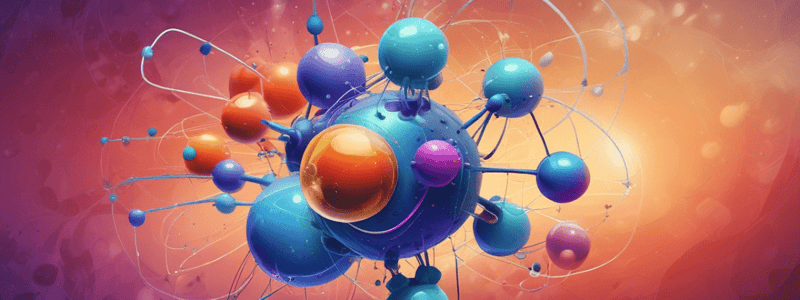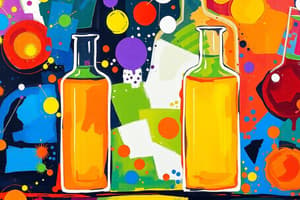Podcast
Questions and Answers
What are the two reactants in cellular respiration?
What are the two reactants in cellular respiration?
- Water and carbon dioxide
- Glucose and carbon dioxide
- Sugar and oxygen gas (correct)
- Oxygen and water
Which of the following is a sign that a chemical reaction has occurred?
Which of the following is a sign that a chemical reaction has occurred?
- Liquid turning into a solid
- No change in color
- Formation of bubbles (correct)
- Decrease in temperature
What is the product of the reaction between glucose and oxygen gas in cellular respiration?
What is the product of the reaction between glucose and oxygen gas in cellular respiration?
- Carbon dioxide and water (correct)
- Glucose and oxygen gas
- Glucose and water
- Carbon dioxide and oxygen gas
Which substance is considered non-toxic and non-reactive?
Which substance is considered non-toxic and non-reactive?
What is a solid precipitate in a chemical reaction?
What is a solid precipitate in a chemical reaction?
What is the main difference between the properties of the reactants and products in a chemical reaction?
What is the main difference between the properties of the reactants and products in a chemical reaction?
What determines whether a chemical reaction has occurred?
What determines whether a chemical reaction has occurred?
Which sign indicates that a gas is being produced during a chemical reaction?
Which sign indicates that a gas is being produced during a chemical reaction?
What are solid precipitates in chemistry?
What are solid precipitates in chemistry?
What makes table salt (sodium chloride) non-toxic for humans?
What makes table salt (sodium chloride) non-toxic for humans?
Flashcards
Cellular respiration reactants?
Cellular respiration reactants?
Sugar and oxygen gas are the reactants.
Sign of chemical reaction?
Sign of chemical reaction?
The formation of bubbles indicates a chemical reaction.
Cellular respiration products?
Cellular respiration products?
Carbon dioxide and water are produced.
Non-toxic/non-reactive substance?
Non-toxic/non-reactive substance?
Signup and view all the flashcards
Solid precipitate?
Solid precipitate?
Signup and view all the flashcards
Reactants vs products properties?
Reactants vs products properties?
Signup and view all the flashcards
Determines a chemical reaction?
Determines a chemical reaction?
Signup and view all the flashcards
Gas production sign?
Gas production sign?
Signup and view all the flashcards
Solid precipitates?
Solid precipitates?
Signup and view all the flashcards
Why is table salt safe?
Why is table salt safe?
Signup and view all the flashcards
Study Notes
Chemical Reactions
- A chemical reaction is a process where the arrangement of atoms is changed, converting reactants into products.
- Reactants are the starting materials, and products are the chemicals produced by the reaction.
- Chemical reactions are represented by an arrow (→) with reactants on the left and products on the right.
Reactants and Products
- Reactants are the ingredients or starting materials of a chemical reaction.
- Products are the result of a chemical reaction, what comes out of the reaction.
- A good analogy for a chemical reaction is baking a cake, where the ingredients are the reactants, and the cake is the product.
Examples of Chemical Reactions
- Na + Cl → NaCl (sodium and chlorine react to form table salt)
- 2H2O → 2H2 + O2 (water breaks down into hydrogen gas and oxygen gas)
- C6H12O6 + 6O2 → 6CO2 + 6H2O (cellular respiration reaction)
What Happens to Atoms after a Chemical Change?
- Atoms are not altered by a chemical reaction, but their arrangement is changed.
- The total number of atoms remains the same before and after a chemical reaction.
- The types and numbers of atoms on both sides of the chemical reaction equation do not change.
Signs of a Chemical Reaction
- A change in color
- A change in temperature
- A gas being produced (e.g. bubbles forming)
- A solid being produced (most often a precipitate)
Studying That Suits You
Use AI to generate personalized quizzes and flashcards to suit your learning preferences.




